Do you want to learn how to ice skate? It can be a lot of fun, and it’s a great way to get some exercise. In this blog post, we will walk you through the steps of how to learn how to ice skate. We’ll start with the basics, like getting on the ice and holding onto the rail, and then we’ll move on to more advanced techniques like moving forward and stopping. We’ll also give you some safety tips so that you can enjoy your time on the ice safely!
How to Ice Skate
These are the steps we are going through:
- get on the ice and hold onto the rail
- try it without the rail
- practice falling and getting up on the ice
- try to move forward
- learn to stop
- practice gliding on two feet
- do a dip
- have fun ice skating
Get on the Ice and Hold Onto the Rail

If you’re new to ice skating, it’s important to hold onto the rail while you’re getting your bearings. The rail will help you keep your balance and prevent you from falling. Once you feel comfortable on the ice, you can let go of the rail and try skating without it. But for now, holding onto the rail is a good way to get started.
Try Ice Skating Without the Rail
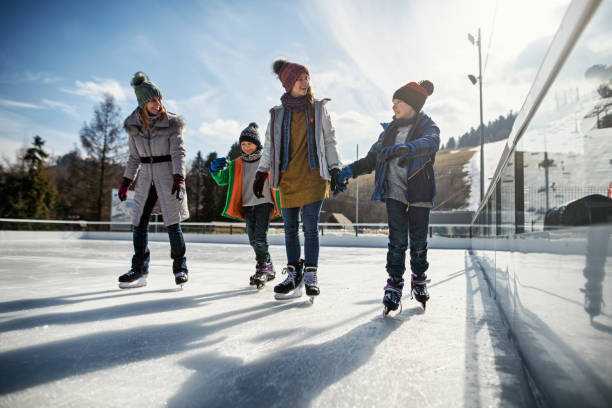
One of the best ways to learn how to ice skate is by trying it without the rail. This may seem counterintuitive, but by holding onto the rail, you are actually limiting your movement and not giving yourself a true sense of how to skate.
Once you let go of the rail, you will be able to move more freely and get a better feel for how to skate. Additionally, you will also be less likely to fall when you are not holding onto the rail. So, if you are serious about learning how to ice skate, be sure to try it without the rail. You may be surprised at how much easier it is than you thought.
Practice Falling and Getting Up on the Ice

Falling and getting up on the ice is important for beginners because it helps them get used to the feeling of being on the ice. It also helps them learn how to balance and how to move around on the ice. When you first start skating, you will probably fall down a lot.
That’s normal. Just get back up and keep skating. Practice falling and getting up until you feel comfortable on the ice. Then you can start learning how to move forward and how to stop. Skating is a lot of fun, but it’s important to be safe.
Try to Move Forward

Once you’re comfortable on the ice and have practiced falling and getting up, it’s time to try moving forward:
- First, push off with one foot to start moving.
- As you glide, use your other foot to push off again and keep moving.
- Remember to keep your knees bent and your back straight as you skate.
- If you need to turn, use your feet to guide you in the direction you want to go.
- To speed up, skate with longer and more powerful strokes.
Learn to Stop

One of the most important things to learn while ice skating is how to stop. There are a few different ways to stop, and which one you use will depend on how much speed you have and how much space you have to work with.
The most common way to stop is to dig your toe pick into the ice rink and slow yourself down that way. Another way to stop is to do a snowplow stop, which is when you skate with your legs in a V shape so that your skates create a wedge against the ice.
If you’re really moving fast, you can do an emergency stop by digging both of your toe picks into the ice rink at the same time and sliding to a stop. This should only be done if you’re in danger of running into something or someone, as it can be very hard on your knees.
Once you know how to stop, practice stopping often so that you can get comfortable with it. Remember to give yourself plenty of space to stop, and always be aware of other people on the ice so that you don’t run into them. With a little practice, stopping will become second nature and you’ll be able to enjoy skating without worry.
Practice Gliding on Two Feet
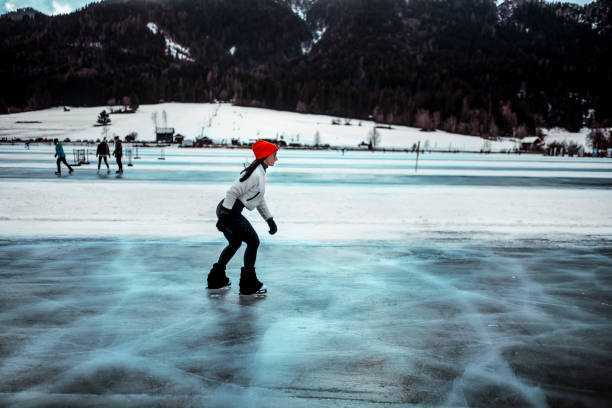
When you are first learning how to ice skate, it is important to practice gliding on two feet. This will help you get a feel for the ice and how your skates move on it.
To glide on two feet, start in a standing position with your feet together. Then, push off with one foot and glide across the ice on the other foot. You can also try gliding backwards or sideways. Just remember to keep your feet together and push off with one foot at a time.
Practicing gliding on two feet will help you get used to the feeling of skating and how to move your feet. Once you feel comfortable gliding, you can start learning how to stop and turn. Just remember to take your time and have fun! Ice skating is a great way to exercise and enjoy the outdoors. So get out there and give it a try!
Do a Dip on the Ice Rink
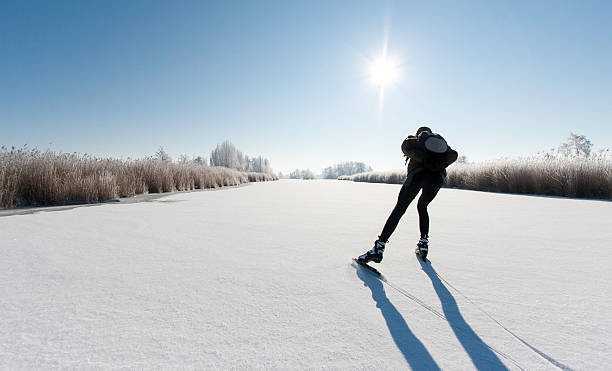
One of the most important things to learn when ice skating is how to do a dip. This move will help you regain your balance if you start to fall, and it will also help you stop more quickly if you need to.
To do a dip, simply bend your knees and lean forward slightly, keeping your arms close to your body. You can practice this move on the ice without moving forward by simply bending your knees and leaning forward until you feel comfortable. If your knees slightly bent, let you glide on the ice 🙂
Once you’re feeling more confident, try doing the dip while moving forward. Remember to keep your arms close to your body and bend your knees as you lean forward. You should feel your weight shifting onto your front skate, and this will help you slow down or stop if necessary.
Have Fun Ice Skating
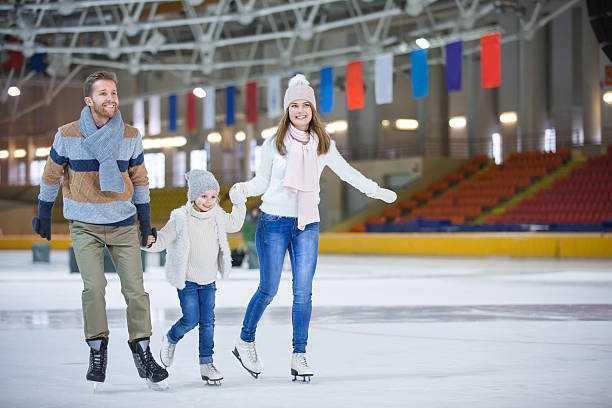
The most essential thing to remember when learning how to ice skate is to have a good time. Skating can be a challenging and frustrating experience, especially at first, but it’s important to stay positive and focus on enjoying the experience.
Getting frustrated will only make it harder to learn how to skate and will make the experience less enjoyable. So, have fun, be patient with yourself, and don’t forget to enjoy the process of learning how to skate. With time and practice, you’ll be skating like a pro in no time!
Safety Tips for Ice Skating
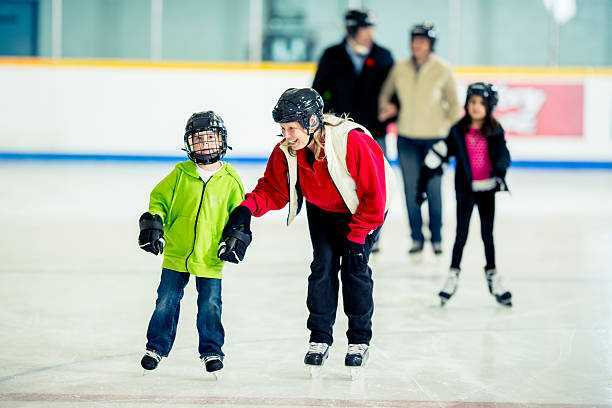
There are also safety tips for ice skating. We have listed the most important:
- Wear proper fitting ice skates that are comfortable and provide good ankle support.
- Dress in layers to stay warm and dry.
- Be aware of your surroundings and other skaters on the ice.
- Start skating slowly and gradually increase your speed.
- Use caution when stopping and avoid sudden stops.
- Practice falling and getting up safely to avoid injury.
- Know your limits and skate within your ability.
- Take breaks often to rest and warm up.
- Drink plenty of fluids to stay hydrated.
- Stretch before and after skating to prevent muscles from becoming sore.
- Listen to your body and stop skating if you feel pain or discomfort.
- Be sure to warm up and cool down properly before and after skating.
- Always skate under the supervision of a responsible adult.
- Wear a helmet, pads, and gloves to protect yourself from injury.
The Different Types of Ice Skates
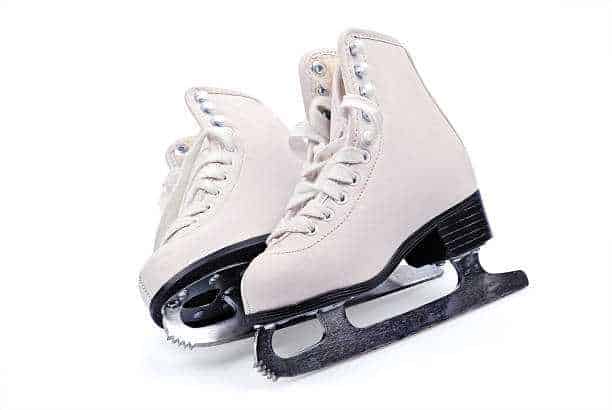
There are three main types of ice skates: figure skates, hockey skates, and speed skates.
Figure Skates

There are many different types of figure skates, but they all have certain features in common. The blades of a figure skate are shorter and sharper than those of a hockey skate, and the toe picks on the front of the blade are used for jumps and spins.
Figure skaters also use wax or other treatments on their blades to help them glide more smoothly over the ice. The boots of a figure skate are lower than those of a hockey skate and provide more support for the ankle.
Hockey Skates

Hockey skates are a type of footwear used by ice hockey players. Hockey skates generally have blades that are about an inch and a half longer than the wearer’s foot, which helps with balance and skating speed. The blades are also curved at the front to help with turning.
Most hockey skaters will wear their skate blades sharpened to a radius between one and three-quarters of an inch. This helps with both skating speed and maneuverability.
Hockey skates are generally made of leather or synthetic materials. The skate’s boot is often reinforced with plastic or composite materials to provide support and stability. The blades of hockey skates are made of high-carbon steel.
Hockey skaters typically wear their skate laces tied tight, in order to provide support and keep the foot from slipping inside the skate. The laces of hockey skates are generally made of nylon or Kevlar.
Hockey skaters will often use a skate guard when they are not on the ice. This helps to protect the blades of the skate from getting damaged. Skate guards are generally made of plastic or rubber.
Speed Skates
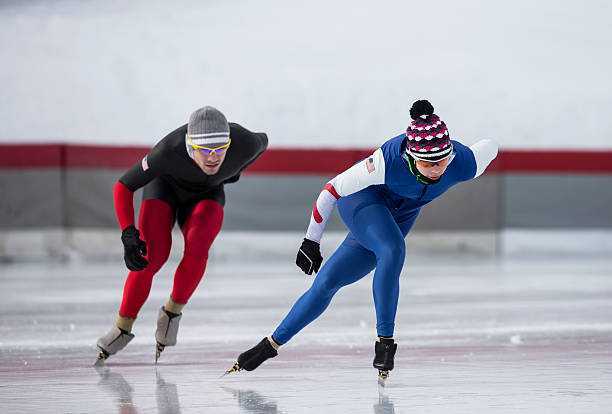
Speed skates are designed for racing on ice. They are shorter and stiffer than figure skates, with blades that are curved forward to help skaters go faster. Speed skating is a popular winter sport in many countries, and speed skaters compete at the Olympics.
If you’re interested in learning how to speed skate, there are a few things you need to know. First, you’ll need to find a pair of speed skates that fit well. They should be snug but not too tight, and they should offer support around your ankles. You’ll also need to find a good pair of racing gloves to protect your hands from the cold.
Once you have your skates and gloves, you’re ready to hit the ice! Start by practicing skating on your own, without the pressure of racing. Get a feel for how the skates glide and how to stop and turn. Once you’re comfortable skating on your own, you can start practicing with other speed skaters.
Speed skating is a great way to get exercise and have fun. But it’s important to be safe while you’re skating. Always warm up before you skate, and cool down after you’re done. And be sure to wear protective gear, like a helmet and pads, if you’re racing.
Final Words
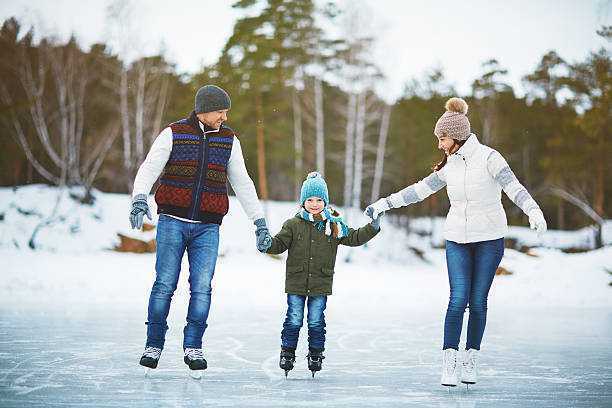
Unfortunately, that’s it with our post! We hope you find this post very helpful!
Never forget, to start with figure skating if you are a beginner! If you’re more experienced, you can also skate backward on the skating rink. For beginner, I highly recommened skating forward on the ice surface to avoird injury and pain.
So, what are you waiting for? Buy new ice skates, bring your own skates with you or rent skates at your ice rink and go for it! I think, most rinks also have a decent pair of skates 🙂
Let me know in the comments below, if you have learned how to skate!


